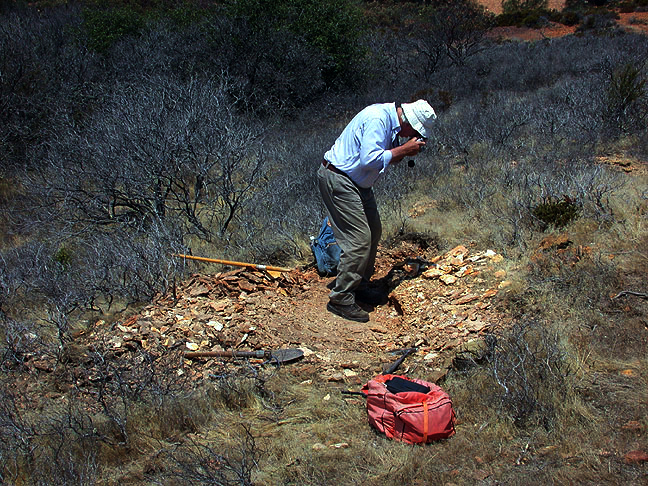|
Paleobotanist Howard Schorn
gets down to business at famous Lygodium Gulch, in the Middle
Eocene Ione Formation, Ione Basin, California. This was late
morning on July 28, 2002, during our first day of digging at
the fossil quarry. Already the sun was blazing, auguring extremes
of 100-plus temperatures for the western foothills of the Sierra
Nevada. But, we were game. We were working hard, plunging mining-style
picks, geology rock hammers and shovels into the Ione strata
there to expose to their first light of day, in some 45 million
years, the beautiful Middle Eocene leaf fossils. The specimens
here are stained a striking reddish-brown on a brilliant white
matrix of shale that contains a high percentage of biotite and
feldspar. Lydodium Gulch is situated high in the lower member
of the Ione Formation, and the rocks carry greater quantities
of feldspar than the primarily quartz-rich and kaolinite clay-saturated
strata lower in the section. The presence of feldspar and biotite
in the Lygodium Gulch section denotes less humid paleoconditions
during deposition of the fossiliferous layer. Image taken on
July 28, 2002.
After our first day of
heavy-duty, brute-force digging by sheer brawn, Howard made a
command decision--he'd hire a local backhoe operator to entrench
Lygodium Gulch, exposing with efficient ease huge blocks of leaf-bearing
shales for us to split with greater effectiveness. We'd found
many quality leaf specimens that day...but, the digging was going
far slower than we'd expected.
Please note: All fossil localities in the Ione
Formation of Amador County, California, presently occur on private
property; explicit permission from the land owners must be secured
before collecting fossils there.
|

